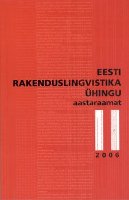Keelekorpused ja võõrkeeleõpe
Language corpora and foreign language teaching
Author(s): Mare KitsnikSubject(s): Language and Literature Studies
Published by: Eesti Rakenduslingvistika Ühing (ERÜ)
Keywords: first language corpora; learner corpora or interlanguage corpora; dictionaries; grammars; teaching methodology; data-driven learning; Estonian as foreign language
Summary/Abstract: The field of teaching Estonian as a foreign language is relatively new and in order to develop it further the following questions should be answered: how to present the language system to the learners in a way that is comprehensible and supports learning the best? how to compile more effective and learner-friendly textbooks, grammars and dictionaries for students of Estonian as a foreign language? what kind of learning method corresponds best to the learners’ needs and language acquisition principles? In the development of foreign language learning the role of language corpora has recently increased significantly. Studying the first language corpora has helped to describe more precisely the uses of authentic language and it has also helped to find out how the language in foreign language learning materials differs from that. So far the studies of corpora have influenced most of all the compilation of dictionaries. There have been created new corpus-based dictionaries: in addition to general lexical and grammatical information they include information about ranking of meanings, collocations, grammatical patterns, style, register and frequency of use. Grammars and textbooks have benefited from the data from corpora, too. There has emerged a new approach called data driven learning. In this method the learners act as researchers who observe the language and discover different patterns in it by using corpora and concordances. In addition to native language corpora the researchers have started to compile learner corpora or interlanguage corpora, which contain texts created by language learners. Investigating interlanguage corpora makes it possible to identify the types of errors the learners make and other characteristic features of interlanguage (vocabulary, collocations, grammatical structures, etc.). In Estonia the corpora have not been studied from the perspective of the foreign language learner’s needs. There are several first language corpora, and Estonian interlanguage corpus is being created at the Chair of General and Applied Linguistics at Tallinn University.
Journal: Eesti Rakenduslingvistika Ühingu aastaraamat
- Issue Year: 2006
- Issue No: 2
- Page Range: 093-108
- Page Count: 15
- Language: Estonian

